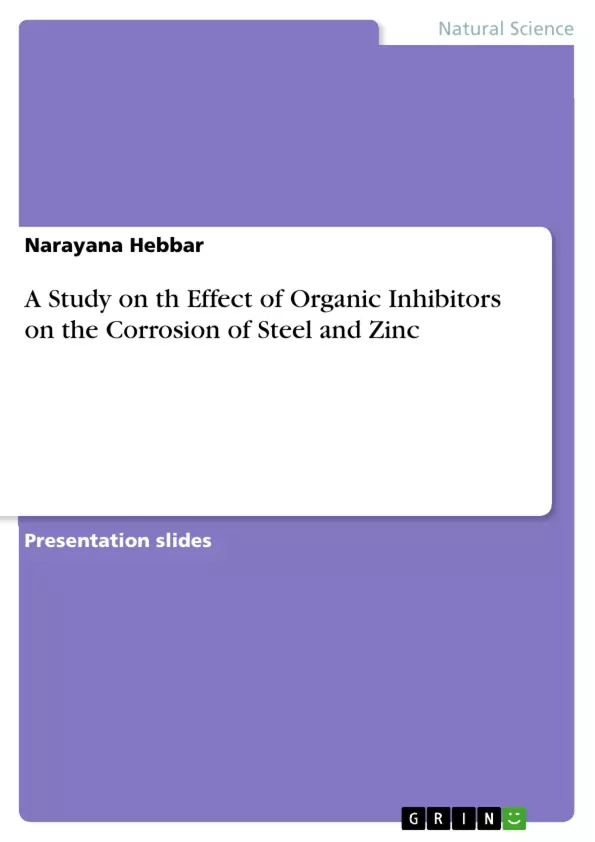This presentation deals with organic inhibitors on the corrosion of steel and zinc.In the19th century, as the result of technological innovations, revolution in the industry, advancement in the science field, there was a growth in agricultural, industrial production, economic expansion and tremendous changes. People have changed the way of manufacturing processes during this time. All the hand works shifted to the machines.
As a result of this revolution, the products were quite cheaper. Mild steel and zinc are very active in the presence of aggressive environment. In the presence of moisture and air, they give respective oxide. It results in the deterioration of metals take place that results in the failures in the industrial equipment in oil industries, gas industries, and water circulating cooling systems. These are main disadvantages of mild steel and zinc. The cause of corrosion of mild steel and zinc and the corrosion control is having critical fundamental, industrial and academic concern .In the existed literature various type of various research groups developed inhibitors.
The developed inhibitors, few of them satisfied all the requirements of the industries and society. Even though they are toxic in nature, they aren’t showing inhibition at high temperature. In addition, no one has discussed complete mechanism of corrosion inhibition. In the present study, more attention is given to developing eco-friendly inhibitors. The complete mechanism of inhibition action of these inhibitors were evaluated by using practical and theoretical studies like weight loss, polarization, impedance, activation parameters, thermodynamic parameters. Scanning electron microscope is used to do morphological studies of the inhibitor. The quantum chemical studies are carried out to correlate the theoretical studies with experimental work of corrosion inhibitors. All the results were agreeing with each other. All the developed inhibitors find applications in industries.
Inhaltsverzeichnis (Table of Contents)
- Introduction
- Literature Survey
- References
- Objectives of the Work
- Methodology
- 1Introduction
- 3Literature Survey
Zielsetzung und Themenschwerpunkte (Objectives and Key Themes)
This research aims to identify new non-toxic inhibitors to control the corrosion of steel and zinc in acidic environments. The study will utilize analytical and theoretical methods to establish the corrosion mechanism.
- Corrosion of steel and zinc in aggressive environments
- The development of effective corrosion protection techniques
- The use of organic inhibitors to control corrosion
- The search for non-toxic corrosion inhibitors
- The mechanism of corrosion in acidic media
Zusammenfassung der Kapitel (Chapter Summaries)
- Introduction: This chapter introduces the subject of corrosion of steel and zinc, emphasizing its impact on various industries and the need for effective protection methods. It discusses the growing concern about the use of toxic corrosion inhibitors and the search for environmentally friendly alternatives.
- Literature Survey: This chapter provides a review of existing research on the use of organic inhibitors for controlling corrosion of steel and zinc. It highlights the effectiveness of nitrogen and sulfur-containing compounds in inhibiting corrosion and discusses the role of protective layers in preventing corrosion.
Schlüsselwörter (Keywords)
The key terms and concepts of this research include corrosion, steel, zinc, organic inhibitors, non-toxic inhibitors, acidic media, corrosion mechanism, analytical methods, theoretical methods, and environmental protection.
- Arbeit zitieren
- Narayana Hebbar (Autor:in), 2017, A Study on th Effect of Organic Inhibitors on the Corrosion of Steel and Zinc, München, GRIN Verlag, https://www.grin.com/document/377109



